Axel Kilian
- Problem Set #1
|
Part 1
|
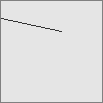 p1.dbn p1.dbn |
// a line
paper 10
pen 80
line 0 83 60 70
|
| |
Create a program to draw a carefully chosen one line on a paper of your choice.
|
Part 2
|
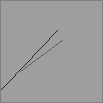 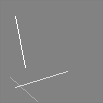 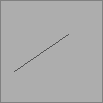 p2.dbn p2.dbn |
// mouse moves the lines
paper 50
forever
{
paper (30+(a/3))
set a (10+( + )/3)
pen a
line (80-a) 30 a a
pen (a+20)
line (a-5) (a+10) (50-a) (5/(a+5))
pen (a-20)
line (10+a) 34 a (99-a)
}
|
| |
Create a program that uses one variable as a means to control a set of 3 lines. Capture 3 instances of the graphic (A,B,C).
|
Part 3
|
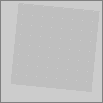 p3.dbn p3.dbn |
// tilted rectangle
paper 20
pen 25
// c tilts the rectangle
set c 8
// s is the height
set s 80
repeat a 0 s
{
line (10+((a*c)/s)) (10+a+c) (90+((a*c)/s)) (10+a)
}
|
| |
Create a program to draw a single filled rectangle. Again, choose carefully.
|
Part 4
|
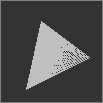 p4.dbn p4.dbn |
paper 80
pen 25
repeat a 25 88
{
line 40 80 a (a/2)
}
|
| |
Create a program to draw a single filled triangle. Use your good judgement.
|
Part 5
|
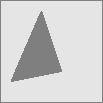 p5.dbn p5.dbn |
paper 10
pen 50
set ax 10
set ay 20
set bx 60
set by 30
set cx 40
set cy 90
set abx (bx-ax)
set aby (by-ay)
set bcx (bx-cx)
set bcy (cy-by)
set acx (cx-ax)
set acy (cy-ay)
set abfx (aby*acx/acy)
set abrx (acx-abfx)
line ax ay bx by
line bx by cx cy
line cx cy ax ay
repeat cl 0 aby
{
line (ax+((cl*abfx)/aby)) (ay+cl) (ax+(cl*(abx/aby))) (ay+cl)
}
//draws upper half
repeat cu 0 bcy
{
line (ax+abfx+((cu*abrx)/bcy)) (by+cu) (bx-((cu*bcx)/bcy)) (by+cu)
}
|
| |
Think of all the ways you can draw a filled triangle, and choose one. Utilize the properties of the drawing method you choose, to create a single filled triangle.
|
Part 6
|
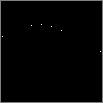 p6.dbn p6.dbn |
paper 100
set c 0
set h 70
set [1 (h-5)] c
set [30 (h+6)] c
set [40 (h+7)] c
set [50 (h+5)] c
set [60 (h+1)] c
set [99 (h-20)] c
|
| |
Set 5 dots on a paper of your choice. Evoke an emotion with your choice in placement of dots.
|
Part 7
|
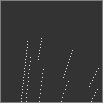 p7.dbn p7.dbn |
paper 80
repeat a 0 20
{
set x (20+(a/3))
set y (a * 3)
set [x y] 10
}
repeat a 0 11
{
set x (25+((a*2)/5))
set y (a * 4)
set [x y] 10
}
repeat a 0 8
{
set x (38+(a/2))
set y (a * 4)
set [x y] 10
}
repeat a 0 5
{
set x (60+((a*7)/5))
set y (a * 4)
set [x y] 10
}
repeat a 0 4
{
set x (90+((a*3)/2))
set y (a * 3)
set [x y] 10
}
repeat a 4 11
{
set x (35+(a/2))
set y (30+(a * 3))
set [x y] 10
}
repeat a 2 11
{
set x (60+(a))
set y (18+(a * 3))
set [x y] 10
}
repeat a 2 8
{
set x (85+((a*3)/2))
set y (9+(a * 3))
set [x y] 10
}
|
| |
Create a representational picture (i.e. something that looks like something) using just 8 (at maximum) dotted lines.
|
Part 8
|
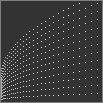 p8.dbn p8.dbn |
paper 80
repeat n 1 33
{
repeat b 1 13
{
set [((n*n)/10) ((b*2)+(n*b)/5)] (33-n)
}
}
|
| |
Using a nested loop, fill the entire field with the value of some calculation that can be appreciated. Do not use the Line command.
|
Part 9
|
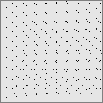 p9.dbn p9.dbn |
paper 0
repeat x 1 10
{
repeat y 1 10
{
set [((10*x)-5) ((10*y)-5+x)] 100
set [((10*x)+(2*y)+x) ((10*y)-(2*y))] 80
}
}
|
| |
Using a nested loop, create a stippled pattern of dots that can be enjoyed for its complexity. Do not use the Line command.
|
Part 10
|
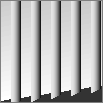 p10.dbn p10.dbn |
paper 80
//glimpse
//background
repeat n 0 5
{
repeat v 1 100
{
pen (n+(v/5))
line (n*20) (v+(n*3)) ((n*20)+10) (v+2+(n*3))
}
}
//the bars
repeat n 0 5
{
repeat v 0 9
{
pen ((v*v)+10)
line ((n*20)+10+v) ((v/2)+(n*3)-3) ((n*20)+10+v) (v+100+(n*3))
}
}
|
| |
Using the Line command, and a (few) nested loop, create an image that evokes a three-dimensional feeling through shading.
|
 p1.dbn
p1.dbn 

 p2.dbn
p2.dbn  p3.dbn
p3.dbn  p4.dbn
p4.dbn  p5.dbn
p5.dbn  p6.dbn
p6.dbn  p7.dbn
p7.dbn  p8.dbn
p8.dbn  p9.dbn
p9.dbn  p10.dbn
p10.dbn